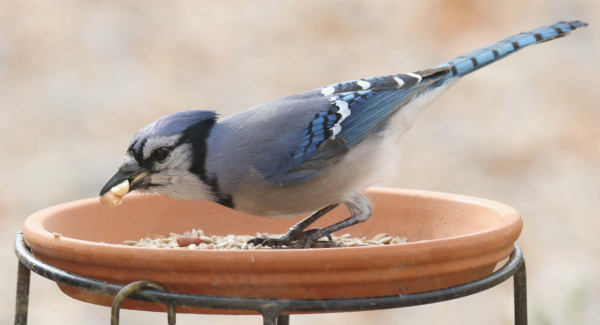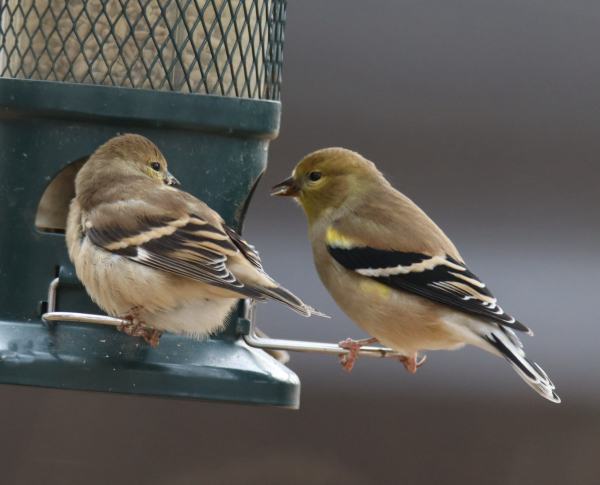
The simplicity of providing shelled sunflower seeds attracts birds like this Purple Finch and avoids the need to clean accumulated shells below feeders.

Jays are beautifully colored and they certainly have an interesting character that adds to the activity at a feeding station (photos by Paul Konrad).

Even the smallest seed-eating birds, like these American Goldfinches, find shelled sunflower seeds to be a preferred food.
|
Ultimately, the types of seeds you provide at your feeders will dictate what birds you will attract. Knowing this, experienced birders narrow the seeds they provide to seeds with the best food value, that will also attract the species of birds they prefer. It’s equally important to avoid seeds that attract unwanted birds that can overpower your feeding station. It's natural to think the more variety the better, but some seeds can lead to problems with domineering birds, squirrels, and other rodents. Sometimes it takes a bit of personal research at your own feeding station, which can be part of the fun.
This could be a very short and sweet article for most birders to benefit from referencing it, because experienced birders tend to concentrate on feeding a few kinds of seeds – primarily black oil sunflower seeds, peanut halves or chips, and nyjer thistle seeds. Black oil sunflower seeds provide the highest food value for most seed-eating birds, and thistle seeds are equally nourishing for smaller seed-eating birds.
Shelled sunflower seeds are definitely a best case option, because they don’t create the mess that accumulates from discarded sunflower shells, and you don’t pay for shells that take a lot of space in a seed bag and add more weight to pay for. Sunflower seed chips are similar, but are cut or chipped to make them smaller for smaller birds to eat, like small finches, although birds like American Goldfinches and Pine Siskins have no problem feeding on shelled sunflower seeds at our feeders.
Many birders prefer to offer nyjer thistle seeds for finches, which are similar to the tiny seeds goldfinches and juncos glean in area fields. Thistle seeds are said to have the most oil content of any seeds, in spite of their small size, but it’s important to offer fresh thistle seeds or they will be ignored. Preferred by some larger birds, peanuts are sure to attract woodpeckers, nuthatches, jays, and others, although peanut chips can be favorites among smaller birds.
It seems that some people don’t like jays, which we have never understood, but jays do tend to be aggressive and displace other birds at a feeding station during their short visits. Even so, they are beautifully colored, some species sport a crest, and they certainly have an interesting attitude to observe from our point of view – we encourage jays to visit our feeding station.
Seeds are the main topic here, but we want to point out that it’s also important to offer suet and fresh water too. And if you live in areas of the Sunbelt where hummingbirds are year-round residents or where hummers overwinter, they will utilize sugar-water nectar in a hummingbird feeder. Plus, if there are winter orioles in your neighborhood, grape jelly and orange halves are a must at your feeding station. Other birds may also appreciate oriole and hummingbird foods – see what species may stop by.
We encourage you to do your own seed research to learn what seeds work best in your feeders to attract the birds you enjoy most. Our personal research has emphasized black oil sunflower seeds and sunflower seed chips (preferably shelled sunflower seeds) as favorites with the exception of some individual woodpeckers and nuthatches that prefer shelled peanut halves or peanut chips. In some areas, safflower seeds are popular, but we will let you make your own judgement on safflower seeds and the birds they attract – we find sunflower seeds supersede safflower seeds.
Fresh nyjer thistle seeds are attractive to smaller birds like finches, siskins, juncos, and native sparrows, but all these birds will also feed on shelled sunflower seeds. The key is to offer shelled sunflower seeds as these birds with smaller beaks aren’t able to crack the shells very well, if at all. We find that after a short time, the smaller seed-eating birds will concentrate on the shelled sunflower seeds, and it’s just simpler to offer one type of seed.
By all means, avoid seed mixes that contain red milo, millet, and cracked corn. So-called “grocery store mixed seeds” and “hardware store mixes” are not recommended because you will usually find they include seeds that most birds don’t eat, they have cracked corn that attracts squirrels and other rodents, and uneaten millet and milo seeds make a mess and need to be cleaned up periodically. These seeds also tend to attract “unwanted” birds to dominate your feeding station – starlings, blackbirds, and House Sparrows are the obvious birds in this category.
As the season progresses, you may wonder what to offer when a new species of bird arrives unexpectedly, say a few Evening Grosbeaks or Redpolls. As long as you are providing shelled sunflower seeds, almost any seed-eating birds will be return visitors, although if you provide “thistle” seeds, you are covering all the bases when included with water and suet. As the winter season arrives with cooler temperatures, finches, cardinals, woodpeckers, and other birds search for dependable food resources, and we wish you Good Luck as you provide an ultimate feeding station to benefit seed-eating birds during the months ahead. We hope it’s a banner year for you to enjoy feeding station visitors.
Share your backyard birding experiences and photographs with The Birding Wire at editorstbw2@gmail.com